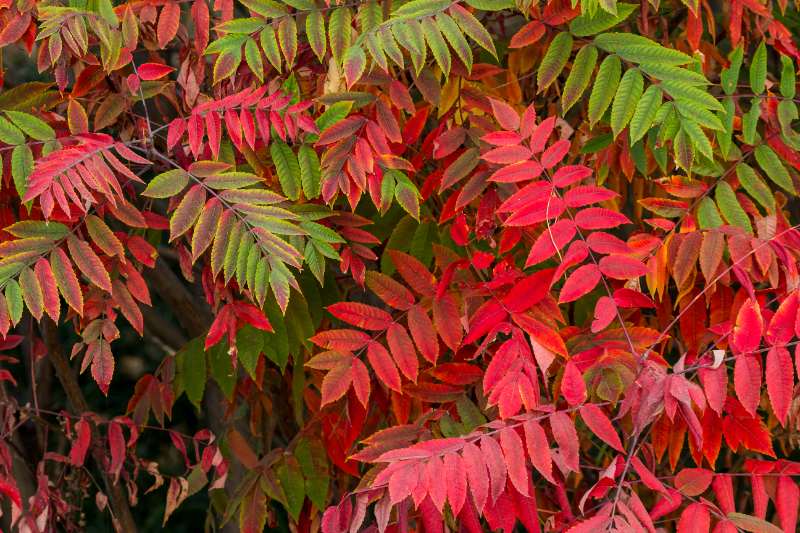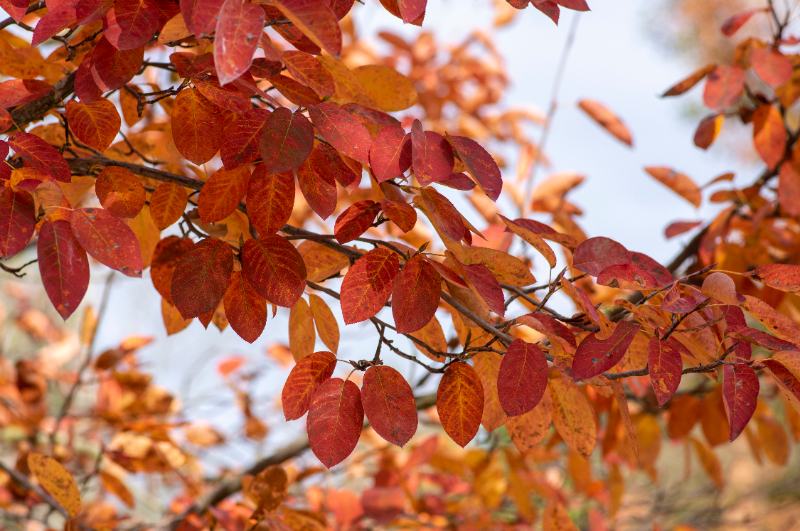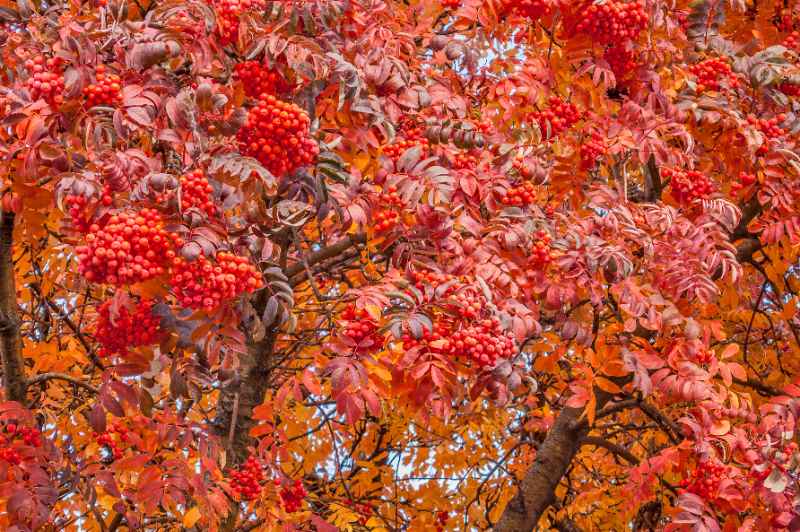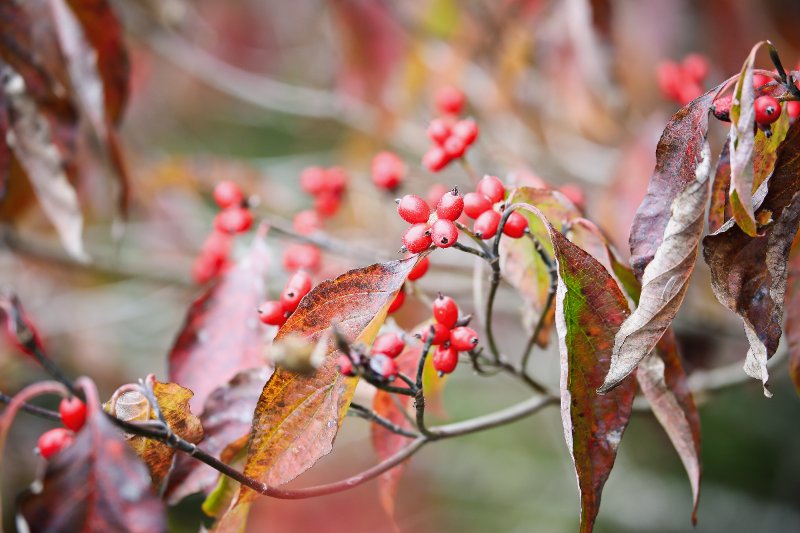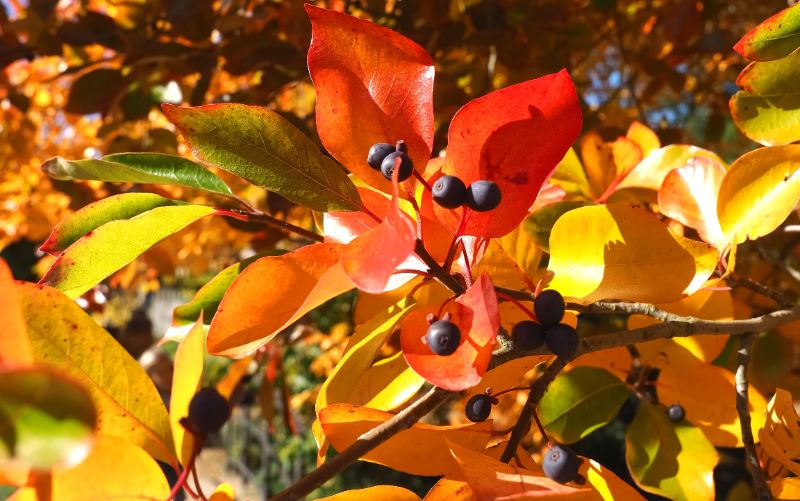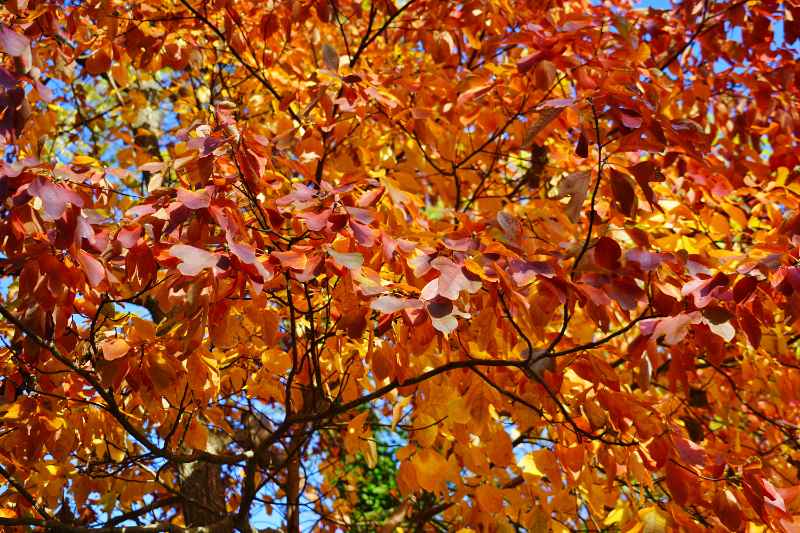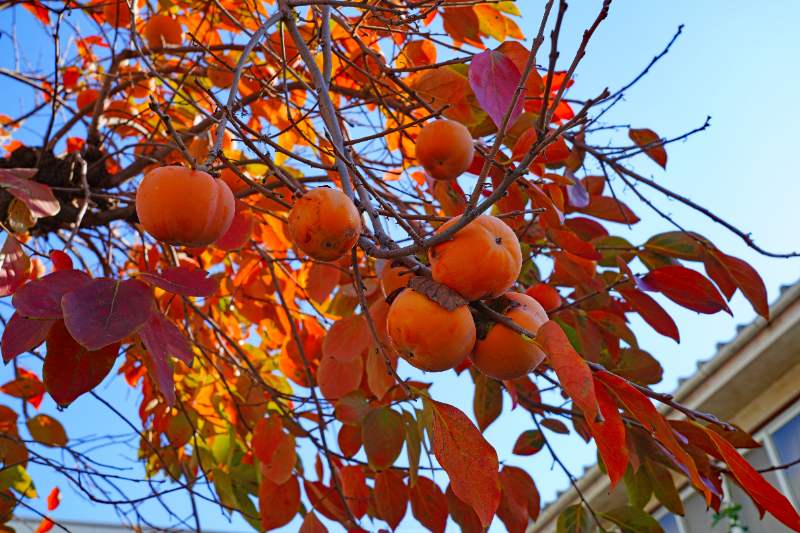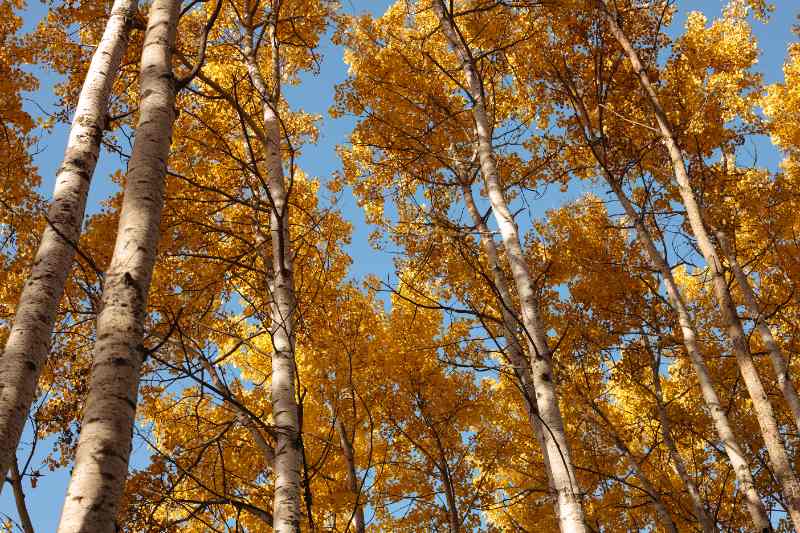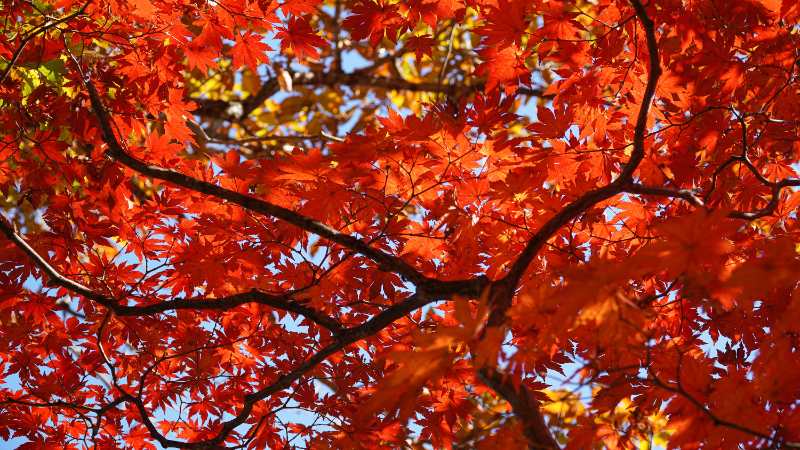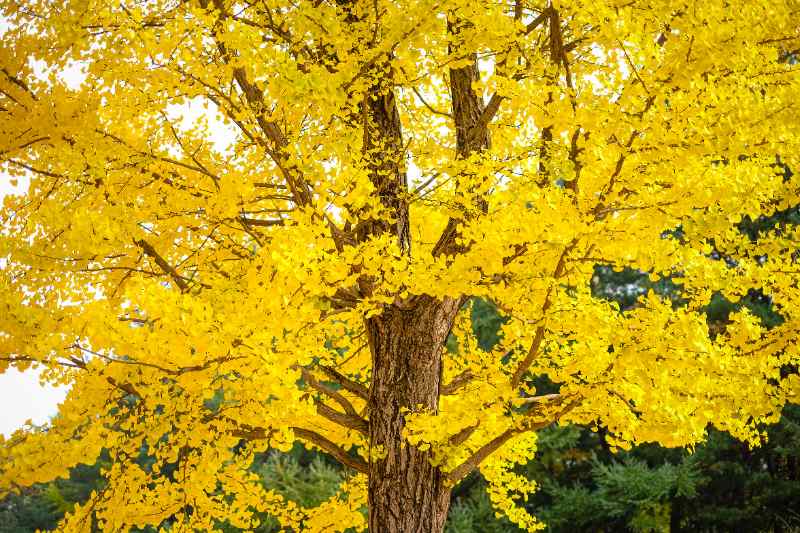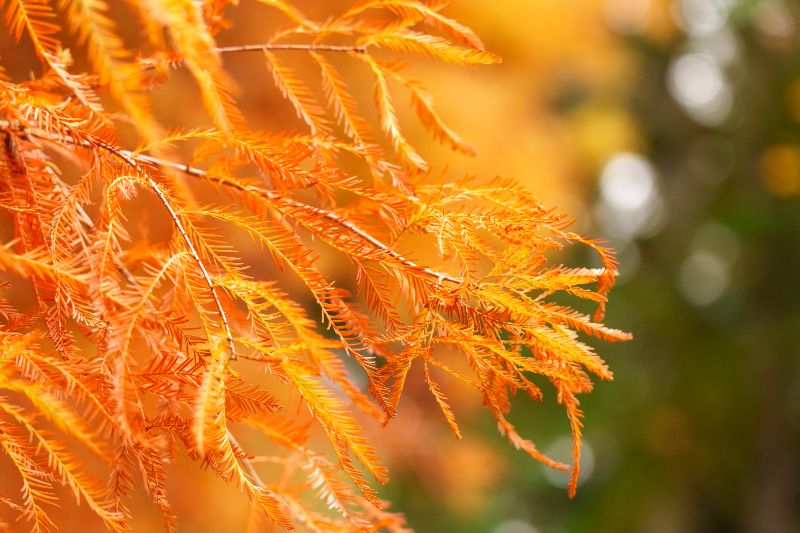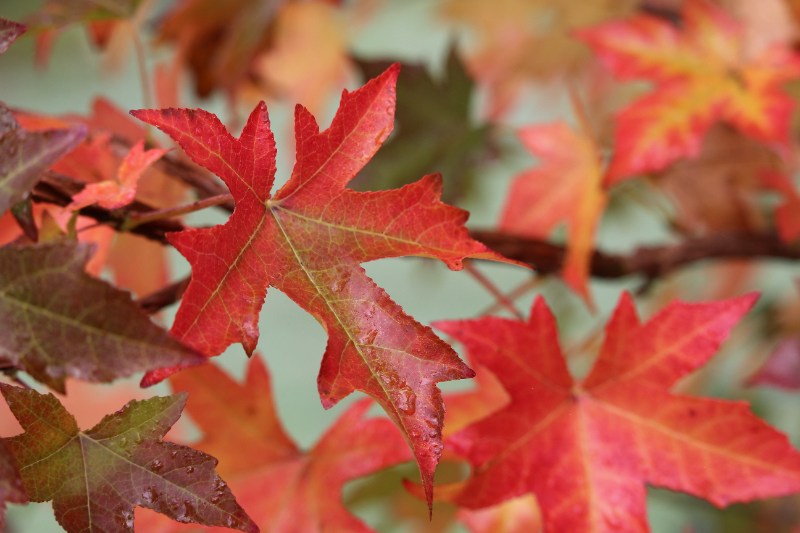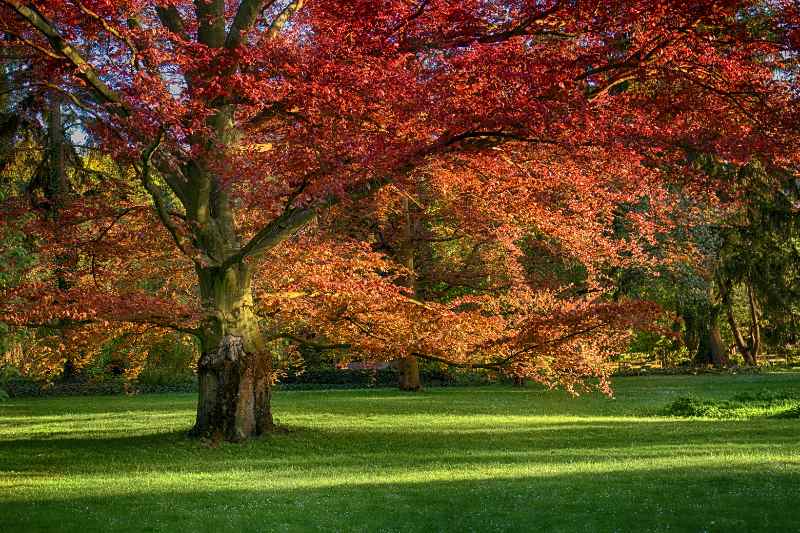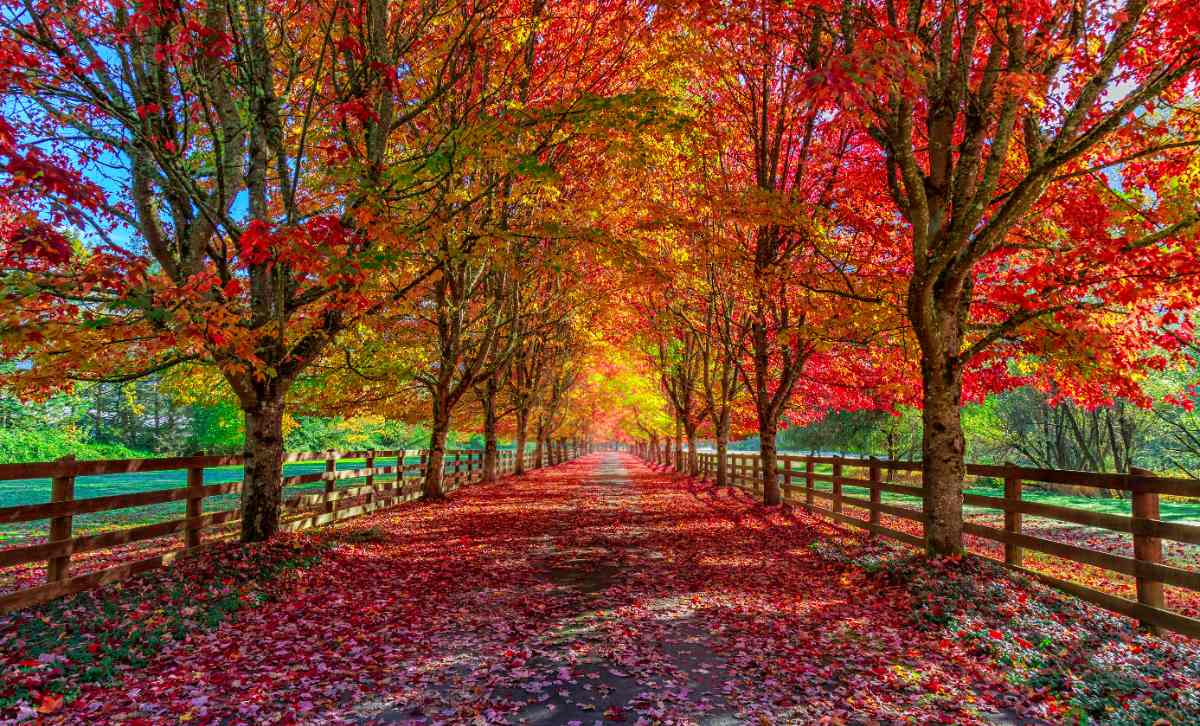
Nothing beats the spectacular show fall foliage puts on in the autumn, and you don’t have to travel states away to experience beautiful color. These 17 trees will turn your landscape into a seasonal masterpiece.
This carefully curated selection of the best trees for fall color, from shortest to tallest, includes some of my personal favorites, discovered through years of hiking, as well as recommendations from landscape professionals and tree experts.
First, Pick Out Your Favorites
Use the slideshow below to choose your favorite trees for fall color. Then, use the table of contents to navigate to your preferred trees to learn more about them.
1. Smooth Sumac
Rhus glabra

- USDA Growing Zones: 2 to 9
- Mature Height: 10 to 15 feet
- Mature Width: 15 to 20 feet
- Fall Foliage Color: Brilliant orange to deep red
- Growing Conditions: Adaptable to poor soils; drought-tolerant; full sun
Smooth sumac is an outstanding choice if you’re looking for reliable fall color with minimal maintenance. This fast-growing native puts on some of the earliest and most vibrant autumn displays. Red berry clusters extend smooth sumac’s seasonal interest well into the winter months.
Nancy Kreith, extension educator with the Illinois Extension, sings its praises for color, adaptability, and purpose: “Brilliant red, orange, and purple in early fall, this tree is known for its ability to survive on poor sites. (It) serves well to stabilize banks and tolerates dry soils.”
2. Serviceberry
Amelanchier spp.

- USDA Growing Zones: 2 to 8
- Mature Height: 15 to 25 feet
- Mature Width: 15 to 25 feet
- Fall Foliage Color: Orange-red to yellow
- Growing Conditions: Adaptable to a variety of soils; full sun to partial shade
With about 30 different species to choose from, the native serviceberry offers white spring flowers, edible summer berries, and reliable fall color. Incredibly adaptable, they tolerate poor soil, drought, and even partially-shaded planting spots.
Serviceberry is perfect for small properties, naturalized areas, or planted as understory trees beneath larger canopies.
Every expert I talked to had something pleasing to say about serviceberry’s great red-orange fall color and edible fruit.
When it comes to cultivars, Kerr recommends ‘Autumn Brilliance’ serviceberry. According to him, they’re “cold-tolerant, minimal-mess,” and grow in pretty poor soils and a range of soil pH values.
Kreith favors ‘Downy’ serviceberry. It has “great year-round interest with bark, spring flowers (before leafing out), fruits,” and its “excellent fall color ranging from yellow to orange and bronze-red,” she says.
3. American Mountain Ash
Sorbus americana

- USDA Growing Zones: 2 to 6
- Mature Height: 15 to 30 feet
- Mature Width: 15 to 25 feet
- Fall Foliage Color: Orange to red
- Growing Conditions: Moist, well-drained soil; cool climates; full sun to partial shade
American mountain ash features white spring flower clusters that give way to “great red-orange foliage color in the fall along with bright orange berries,” says Karen Panter, emeritus professor and retired extension horticulture specialist with the University of Wyoming. The small, flame-colored berries are an ideal snack for birds and other wildlife.
This beautiful native tree is ideal for northern landscapes and thrives in cool, mountainous regions where many other trees struggle to survive.
4. Flowering Dogwood
Cornus florida

- USDA Growing Zones: 5 to 9
- Mature Height: 15 to 30 feet
- Mature Width: 15 to 30 feet
- Fall Foliage Color: Red to purple
- Growing Conditions: Well-drained, acid soil rich in organic matter; partial shade
The best description comes from Kreith: The flowering dogwood is “a beautiful native understory tree. It has consistent red to reddish-purple fall color. Similar to serviceberry, it has great year-round interest, (putting on an) outstanding spring flower display without leaves.” According to her, it “makes an excellent specimen tree.”
Dogwood trees are perfect accent platings for smaller landscapes and woodland gardens. They prefer protection from harsh afternoon sun and benefit from mulching around the base to keep the roots cool.
5. Black Gum/Tupelo
Nyssa sylvatica

- USDA Growing Zones: 4 to 9
- Mature Height: 30 to 50 feet
- Mature Width: 20 to 30 feet
- Fall Foliage Color: Intense scarlet-red
- Growing Conditions: Adaptable to various soils, tolerates wet areas; full sun to partial shade
If you’re looking for early-season fall color, look no further than black gum trees. They are often among the first to start changing colors in the fall, producing incredibly intense red foliage in mid-to-late September or early October: “amazing fall color that shows up from a distance,” Kreith adds.
This native tree is incredibly adaptable, thriving where other trees struggle. It also provides berries for birds and supports native pollinators.
A staple tree in the eastern U.S., Aaron Steil, consumer horticulture extension specialist with Iowa State University, recommends black gum. He says it’s “one of the most impressive fall color displays that you can find in a tree – rivals even maples!…Look for cultivars like Afterburner (‘David Odom’) and Firestarter (‘JFS-Red’) for their upright compact shorter habit and ‘Wildfire’ for its eye-catching red new growth in spring.”
6. Sassafras
Sassafras albidum

- USDA Growing Zones: 4 to 9
- Mature Height: 30 to 60 feet
- Mature Width: 25 to 40 feet
- Fall Foliage Color: Brilliant yellow, orange, and red (often all three colors on the same tree)
- Growing Conditions: Adaptable to various well-drained soils; full sun to partial shade
Sassafras offers exceptional fall color with its unique mitten-shaped leaves turning brilliant combinations of yellow, orange, and red simultaneously. The bark is known for its spicy, aromatic scent, often described as a blend of cinnamon, star anise, and citrus, with a hint of vanilla.
Native to the Southeast and the Appalachian regions, it thrives in these areas where Kreith says “it requires little to no upkeep” and is drought-tolerant. It’s a perfect tree for homeowners in eastern climates seeking a reliable autumn spectacle with distinctive character.
7. American Persimmon
Diospyros virginiana

- USDA Growing Zones: 4 to 9
- Mature Height: 35 to 60 feet
- Mature Width: 20 to 35 feet
- Fall Foliage Color: Yellow to orange
- Growing Conditions: Adaptable to various soils; drought-tolerant; full sun to partial shade
Beautiful fall color, plus edible fruit? It’s a winning combination on the American persimmon tree. Trees provide a lovely yellow to orange color, along with sweet fruit that ripens after the first frost.
These natives are extremely drought-tolerant and adaptable to a range of planting conditions; they’re valuable for challenging soils and offer wildlife food and distinctive bark patterns for winter interest.
8. Quaking Aspen
Populus tremuloides

- USDA Growing Zones: 1 to 6
- Mature Height: 20 to 50 feet
- Mature Width: 10 to 25 feet
- Fall Foliage Color: Bright golden-yellow
- Growing Conditions: Moist, well-drained soil; cool climates; full sun
One of my personal favorites — especially when hiking in the mountains — “quakies” create shimmering golden orange-red displays that are absolutely magical, even when its leaves are covering the ground. Their leaves flutter in the slightest breeze, enhancing the dramatic visual effect. These trees often form attractive groves through root sprouting, creating immense natural colonies.
Panter says they are “quite hardy.” She notes they have a short life span, but these fast-growing trees serve a purpose in challenging mountainous and northern climates where other trees struggle.
9. Red Maple
Acer rubrum

- USDA Growing Zones: 3 to 9
- Mature Height: 40 to 60 feet
- Mature Width: 25 to 45 feet
- Fall Foliage Color: Bright yellow to deep crimson red
- Growing Conditions: Adaptable to most soils and moisture conditions; full to partial sun
Red maples grow faster and are more adaptable than sugar maples. Kreith says they offer “great fall color.”
They’re excellent for difficult sites and provide quicker results for homeowners looking to establish a fast-growing shade tree. With many types available, it’s easy to find one suitable for your landscaping needs.
10. Ginkgo
Ginkgo biloba

- USDA Growing Zones: 4 to 8
- Mature Height: 50 to 80 feet
- Mature Width: 30 to 40 feet
- Fall Foliage Color: Brilliant golden-yellow
- Growing Conditions: Well-drained soil; full sun
The last surviving species of an ancient lineage, gingkos are living fossils characterized by their unique fan-shaped leaves. They are incredibly hardy trees, making them perfect for urban environments or rocky soils. Come fall, they provide spectacular, uniform displays of golden fall color.
When choosing ginkgo trees, Kreith recommends to “select males since the fruit on females has an off-putting smell” and can be messy.
11. Bald Cypress
Taxodium distichum

- USDA Growing Zones: 4 to 10
- Mature Height: 50 to 80 feet
- Mature Width: 20 to 30 feet
- Fall Foliage Color: Russet-orange to bronze
- Growing Conditions: Adaptable to wet or dry soil; full sun
Despite being a conifer, bald cypress produces spectacular russet-orange fall color before dropping its needles, making it unique among evergreens. With distinct buttressed trunks, fine-textured soft foliage, and adaptability to both swampy sites and drought conditions, these trees are fascinating.
They’re particularly valuable in southern regions and spots with drainage issues.
Steil explains, “Many home lawns have poor, compacted soils that drain poorly, especially those in new developments. This tree tolerates that very well.” Look for “upright cultivars, like Shawnee Brave (‘Michelson’) and smaller compact cultivars like Lindsey’s Skyward (‘Skyward’)” for residential landscapes.
12. American Beech
Fagus grandifolia

- USDA Growing Zones: 3 to 9
- Mature Height: 50 to 80 feet
- Mature Width: 40 to 60 feet
- Fall Foliage Color: Bronze to copper
- Growing Conditions: Rich, well-drained soil; full to partial sun
Slow-growing but long-lived, Kreith touts the magnificent native American beech as “superior in fall color compared to European beech.” It provides beautiful bronze to copper fall color that often clings to branches well into winter, extending seasonal interest. The “silvery, smooth bark is attractive” year-round, she says.
American beech trees prefer rich, organic soil and prefer to be planted where they’ll be protected from harsh winds. They are excellent for larger properties with space for their impressive mature size.
13. Scarlet Oak
Quercus coccinea

- USDA Growing Zones: 4 to 9
- Mature Height: 60 to 80 feet
- Mature Width: 40 to 50 feet
- Fall Foliage Color: Brilliant scarlet-red
- Growing Conditions: Well-drained, acidic soils; drought-tolerant; full sun
True to its name, scarlet oak produces some of the most brilliant red fall foliage of any tree, even rivaling the best maples. Noted by Kreith, it has “excellent fall color with leaves that persist” into winter.
As a native oak, it’s also incredibly durable — once established, it’s extremely drought-tolerant and requires minimal care.
Scarlet oak is a fantastic tree for larger properties wanting reliable fall color with the durability oaks are known for.
See Related: 20 Best Drought-Tolerant Trees by Region
14. American Sweetgum
Liquidambar styraciflua

- USDA Growing Zones: 5 to 9
- Mature Height: 60 to 75 feet
- Mature Width: 40 to 50 feet
- Fall Foliage Color: Yellow, orange, red, and purple simultaneously
- Growing Conditions: Moist, well-drained, acidic soil; full sun
Sweetgums offer some of the most diverse and spectacular fall displays. Per Kreith: “Leaves can range from red, orange, yellow, and purple. Some trees have a combination of all colors, while others have a few, and sometimes green ones are mixed in.”
They’re particularly valuable in larger southern and mid-Atlantic properties where reliable fall color can be difficult to achieve due to warmer temperatures and more variable weather patterns.
15. Sugar Maple
Acer saccharum

- USDA Growing Zones: 3 to 8
- Mature Height: 60 to 80 feet
- Mature Width: 40 to 60 feet
- Fall Foliage Color: Brilliant orange, red, and yellow
- Growing Conditions: Well-drained, slightly acidic soil; full to partial sun
Sugar maples are the gold standard for fall color. These slow-growing, long-lived trees become more spectacular as they age. They provide excellent shade during the summer, and as native trees, they are relatively low-maintenance once established.
They prefer cooler climates and may struggle in areas with hot, humid summers or high levels of urban pollution. Sugar maples are ideal for suburban and rural northern landscapes.
16. Shagbark Hickory
Carya ovata

- USDA Growing Zones: 4 to 8
- Mature Height: 70 to 80 feet
- Mature Width: 50 to 60 feet
- Fall Foliage Color: Golden yellow
- Growing Conditions: Well-drained soil; tolerates a range of soil pH; full sun to partial shade
Shagbark hickory is an exceptional choice for large properties. This native tree offers brilliant golden fall color, distinctive shaggy bark for year-round interest, and edible nuts.
Extremely durable and long-lived, it provides excellent shade while requiring minimal care once established. The species thrives from drier uplands in the northernmost eastern U.S. to moist, fertile valleys in the South.
This tree isn’t one people think of immediately when looking for fall color, but that’s part of its draw. Native shagbark hickory isn’t often seen, but per Steil, “(it’s) a great way to introduce more diversity to the neighborhood tree canopy. Diversity is important because it promotes a more resilient urban forest ecosystem that withstands diseases, pests, and weather extremes better”.
17. Red Oak
Quercus rubra

- USDA Growing Zones: 3 to 8
- Mature Height: 60 to 80 feet
- Mature Width: 60 to 80 feet
- Fall Foliage Color: Russet red to brown
- Growing Conditions: Well-drained, acidic soil; full sun to partial shade
With “a fast growth rate in its juvenile stage,” per Kreith, the red oak develops into a magnificent, towering tree with a broad, rounded crown. The large, lobed leaves “(make it) an excellent shade tree for larger landscapes” before turning rich fall colors in late October. “The clean foliage and good fall color” make it one of her picks for oaks.
This native tree combines rapid growth with the longevity and strength that are characteristic of oaks. They thrive across the eastern United States.
See Related: Turn Your Yard Into a Certified Wildlife Habitat
FAQ About Adding Vibrant Fall Color to Your Landscaping
Succession planting is the best way to extend fall colors. Plant black gum or sugar maples that turn early, add some dogwood or sassafras for mid-season color, and include late-changers like red oak and American beech. Then, protect your trees from harsh winds to prevent leaf drop.
See Related:
• What to Do With Fallen Leaves in Your Yard
• How Much Does Leaf Removal Cost?
• Best Ways to Clean Up Leaves in Your Yard
When talking about color intensity, Panter had this to say: “(Great) fall color is highly dependent on how healthy the trees are to begin with. Adequate watering during the year (we water during the winter here in the Rocky Mountain west) as well as proper tree planting and maintenance all help those trees develop their best autumn hues.”
You can influence the vibrancy by ensuring the soil pH is within a reasonable range, the tree receives consistent water, has adequate sunlight, and the soil is well-draining. Don’t fertilize too late in the season, prune regularly (and at the right time), and manage pest and disease problems efficiently.
Autumn colors typically last 3 to 6 weeks in most regions before the leaves fall, but factors such as geographic location, weather conditions, and tree species all impact the duration. Northern colors tend to last longer than those in the South; wind, storms, and frost shorten displays; and higher elevations start earlier but tend to last longer due to cooler temperatures.
Turn Your Yard Into a Fall Masterpiece

Creating a spectacular fall landscape takes proper planning, careful planting, and routine year-round tree care, including leaf removal service after leaf drop in fall.
Professional help can take the burden off your shoulders, whether it’s selecting the tree, trimming, fertilizing, disease treatment, or pest control. Contact LawnStarter and connect with our local tree professionals to guarantee breathtaking fall displays.
Read More:
- Tips for Choosing a Tree at the Nursery
- How to Pick the Right Site to Plant a Tree
- How Much Does it Cost to Plant a Tree?
- How to Plant a Tree
Main Image: Maple trees line a driveway during autumn. Photo Credit: Diane / Adobe Stock
Sources
- Aaron Steil, Consumer Horticulture Extension Specialist at Iowa State University Extension and Outreach, Ames, IA. Personal interview.
- Eric Kerr, ISA Certified Arborist and Tree Care Expert at Kerrific Trees, Idaho Falls, ID. Personal interview.
- Karen L. Panter, Emeritus Professor and Retired Extension Horticulture Specialist at University of Wyoming, Laramie, WY. Personal interview.
- Nancy Kreith, Extension Educator, Horticulture at Illinois Extension, University of Illinois Urbana-Champaign, Matteson, IL. Personal interview.
